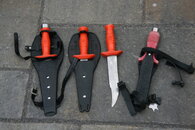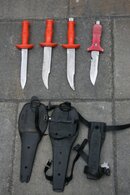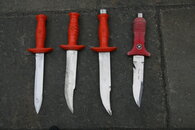I have a real distaste for dull knives, and so won't own one which cannot be sharpened to a razor edge, and keep that edge. The dive knife is an important part of the diver's equipment, and I have used mine multiple times to cut lines and fishing lines which had entangled with me, and at one point freed a fishing boat from a heavy net which had a rope about 3 inches in diameter attached to it and wrapped around its prop (and that was at Thetis Island, B.C. in 1962). My very sharp dive knife also helped me out in Pararescue on two occasions, the first in training, and without even being drawn:The biggest problem with dive knives in general, and BFKs specifically, is they come as dull as a butter knife and not many of us knows how to sharpen them. At least a dull BFK can be used as a hammer or club.
The second time was on at actual mission, when I had to use my knife to extricate the bodies of two ROKAF pilots who had unfortunately ejected through their canopy as they crashed into the water of the Yellow Sea. Here is the mission report I wrote to the Republic of Korea Air Force about this mission:We finally completed the last jump, a night water jump which turned into a disaster for me. We jumped into Eglin Bay from a HC-130. It was a very dark night, and I was leery about the jump for some reason. Usually I liked jumping by now, but this was a full scuba jump, with the tanks, the reserve parachute, a medical kit, and a butt-boat (one-man survival raft). Looking out the door, I could see almost nothing as we were not dark-adapted for the jump (the lights in the plane had not been dimmed).
I jumped, felt a good opening, and was relieved to be out of the heat of the plane. The water was less than a minute below me. After checking the ‘chute, my next task was to pull the pins of the risers so I could steer. But something was not right with my right riser group. Rather than going up at an angle, these two risers went straight up. I looked up, and there was a wrap of parachute line from the rear of the skirt down to the risers, which had been looped over the other riser, forming a half hitch around both risers. This kept the two risers together, and made it impossible to use this riser group for steering. We were still using the slip-riser method of steering the canopy by distortion of the rear steering oval in the ‘chute. With only one riser group to steer with, I made a poor, down-wind landing into the water. I hit hard on my fins, then dove face-first into the inky black, salty bay. Coughing and sputtering, I got to the surface just in time for the canopy to start pulling me through the water. Still face-down, I grabbed another breath, and released the left Capwell Quick-release. The risers flung away, and I was at last free on the surface, or so I thought.
While I rested, the current in the bay and the wind carried me into the unseen parachute shroud lines, and they began tangling around my diving tank and regulator. When I was pulled from the water, I had these lines all over my tank and my leg. It took a few minutes to clear up the mess. Then I was asked by one of the instructors, “What would you have done if this was a mission?” The implication was that I would have needed rescuing rather than being the rescuer.
I had a good reply, and pulled out my diving knife with its seven-inch long blade, the orange-handled Sportsways dive knife with the Soligen stainless steel I had gotten from my parents several years prior for my birthday. Unlike the military-issue knives, with Japanese “stainless” steel that rusted and which would not hold an edge (and rarely were sharpened), this knife was razor sharp. I told them that I simply would have cut those lines off me like I did the fishing line that was a perpetual problem for divers in the Pacific Northwest. But in a training situation, I couldn’t do that as it would destroy a valuable parachute. On a mission, the parachute was expendable, and they usually were allowed simply to sink.
I then told them of my problem with the riser, and the half-hitch over the group which precluded my using it for steering. I’m not sure that they believed me, but this allowed me to get through the jump. To this day I don’t know if that was purposely done in packing the chute, or accidentally happened either in the packing or the deployment.
From Between Air and Water, the Memoir of an USAF Pararescueman," unpublished but hopefully soon to be; Copyright 2018, John C. Ratliff
The knife I was using then was a Sportsway knife, as seen below (the one with the serrations toward the point on top of the knife. I now dive the Wenoka knife that is also shown, as it's sheath is a one-handed operation.1625/JCR, Mission # Det 3, 41st ARRWg 007, March 13, 1969
I had very little visual contact with the victims or their equipment before my deployment into the water because I was busy putting on my diving equipment. I was in the door about 10 seconds before TSgt Maxwell tapped me out of the helicopter. The helicopter was in about a 15 foot hoover when I jumped. After entering the water, I swam to the victim and tried to lift him to the water's surface. He was too heavy. Underwater visibility was about six (6) inches. It was hard to determine which part of the victim (arm or leg) I was holding. It was his arm. I found one of his Capewell quick releases for his parachute, which was deployed in the water, and released it. Then I turned him over to get to the other release, and released it also. I tried to blow up his LPU,1 but couldn't find them. The victim's face was bloody and he didn't have a helmet on. After releasing the parachute, I swam him away from his life raft and parachute. I had to cut parachute suspension lines which were tangled around his feet and my swim fins and the tether to his life raft. I signaled for a helicopter pickup of the first victim. The HH-43 helicopter lowered a rescue seat to me, which I disconnected, and hooked the hoist's hook to the victim's parachute harness.
After the first victim was aboard the helicopter, I looked around for the other victim. I saw a helmet, swam to it towing the rescue seat, but the victim wasn't there. I strapped the helmet to the seat. The second helicopter guided me to the second victim.
I swam to the second victim, swimming around his parachute to keep from getting tangled in the lines. I found some suspension lines beside the victim and cut them. I then cut the risers (on the victim's right side, I believe), disconnected the Capewell quick release from the parachute risers on the other side, and checked to see if the victim was tangled in lines. He was not tangled. I also tried to locate his LPU to blow them up, but again couldn't find them. Then I signaled for a second hoist pickup, which was accomplished the same manner as the first.
When the second victim was aboard, I swam to the rescue seat, strapped myself into it, and I was picked up.
Headquarters
Republic of Korea Air Force
Seoul, Korea
1 LPU--Life Preserver, Underarm
From Between Air and Water, the Memoir of an USAF Pararescueman," unpublished but hopefully soon to be; Copyright 2018, John C. Ratliff
Sharpening a knife is a skill I learned from my father, and involves setting the edge with a coarse sharpening stone, then going to the fine stone on the other side, followed by sharpening on a marble stone, and finishing with a sharpening steel to set some grooves into the edge. You have to know how to hold the knife at a specific angle to get the edge correctly aligned too. This skill must be practiced to be effective, and the knife must have good steel in order to hold an edge.
The USAF diving knife we were issued, which I never carried, was one by U.S. Divers Company, what stated "Stainless Steel, Made in Japan" and rusted as soon as it hit salt water. It's steel was too soft to hold an edge.
SeaRat
Attachments
Last edited:






